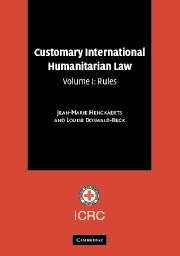Book contents
- Frontmatter
- Contents
- Foreword by ICRC President Jakob Kellenberger
- Foreword by Judge Abdul G. Koroma
- Foreword by Yves Sandoz
- Acknowledgements
- Introduction
- List of abbreviations
- Part I The Principle of Distinction
- Part II Specifically Protected Persons and Objects
- Part III Specific Methods of Warfare
- Part IV Weapons
- Part V Treatment of Civilians and Persons Hors De Combat
- Part VI Implementation
Introduction
Published online by Cambridge University Press: 05 June 2012
- Frontmatter
- Contents
- Foreword by ICRC President Jakob Kellenberger
- Foreword by Judge Abdul G. Koroma
- Foreword by Yves Sandoz
- Acknowledgements
- Introduction
- List of abbreviations
- Part I The Principle of Distinction
- Part II Specifically Protected Persons and Objects
- Part III Specific Methods of Warfare
- Part IV Weapons
- Part V Treatment of Civilians and Persons Hors De Combat
- Part VI Implementation
Summary
International humanitarian law has its origins in the customary practices of armies as they developed over the ages and on all continents. The “laws and customs of war”, as this branch of international law has traditionally been called, was not applied by all armies, and not necessarily vis-à-vis all enemies, nor were all the rules the same. However, the pattern that could typically be found was restraint of behaviour vis-à-vis combatants and civilians, primarily based on the concept of the soldier's honour. The content of the rules generally included the prohibition of behaviour that was considered unnecessarily cruel or dishonourable, and was not only developed by the armies themselves, but was also influenced by the writings of religious leaders.
The most significant landmark from the point of view of cataloguing these customs in one document was the drafting by Professor Francis Lieber of the Instructions for the Government of Armies of the United States in the Field, promulgated as General Order No. 100 by President Lincoln in 1863 during the American Civil War. The Lieber Code, as it is now known, strongly influenced the further codification of the laws and customs of war and the adoption of similar regulations by other States. Together, they formed the basis of the draft of an international convention on the laws and customs of war presented to the Brussels Conference in 1874.
- Type
- Chapter
- Information
- Customary International Humanitarian Law , pp. xxv - liPublisher: Cambridge University PressPrint publication year: 2005
- 4
- Cited by

